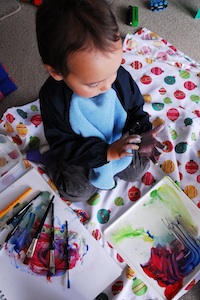In a time where the school curriculum seems to become narrower and narrower, outlets for expressing creativity are becoming more and more vital in the lives of our children. But how to make a more creative life for your kids?
Schools are time-pressured to deliver lessons around literacy and numeracy and as such, subjects such as art, music, drama and dance tend to suffer the most. Unfortunately, many of our children who find literacy and numeracy difficult, have talents in the arts areas that, without stimulation, will go unnoticed.
Many of our challenging boys, for example, often have shown incredible artistic, musical or dancing ability – and seem to take on a whole new persona when in the midst of creating their own unique piece.
Children need to be creative daily. It is important for their development to have opportunities to think outside the square, to look at things in new ways, to problem-solve but most importantly, to feel a sense of success when they have completed their ‘creation’, whatever it may be.
I am fortunate to live with an artist. My husband is a tattooist. He is also a painter and a very alternative thinker. I say I am fortunate, because we have nothing but creativity in our household and we celebrate this often.
I am not an artist – and I therefore can appreciate the talents that some people have to offer so much more. I encourage my husband in his art, simply due to my envy of my own lack in artistic skills!
I remind him it is his duty to share his talents with the world, especially for those like myself who cannot do what he can. My husband did not do well in school. Not because he wasn’t capable of it – he just wasn’t engaged in school, like many male youths. He also suffered through a period of time where he was unable to paint and draw as he would’ve liked.
He often reflects now that he would’ve enjoyed becoming an architect or designer, could he do it all again. The most profound observation I have made though, of my artist husband, is that if he is not able to paint, draw or tattoo – he is just a shell of himself. The longer he is unable to express himself creatively, he struggles to connect with his true self. The person he was designed to be.
This will ring true for many of our students. If they are unable to find a creative outlet, they will not be able to truly be themselves.
The ramifications of this are numerous. For students who find school difficult to engage with, this will add to their reduced feelings of self-worth, self-belief and self-esteem. They will struggle to build resiliency skills and manage themselves against what life has to throw at them.
And let’s face it, for those of you that know artists, they can be a rather sensitive lot! So as adults, we must take extra care to provide opportunities for children to create and express their talents in ways that they may not have provided for at school.
So how do we support our children’s creativity, when schools are struggling to find the time?
We have started very simply in our household. When one of the children brings in a painting – no matter how it looks – we celebrate it. We have a ‘Wall of Fame’ – a place where these creations are put on display for all to see and comment on.
We discuss the choices the children made in their colours, the shapes and often the textures. We simply are an appreciative audience.

A second simple way to encourage creativity in your household is to have a ‘making box’.
Grab a plastic bin from Mitre 10 or the Warehouse and instead of throwing away your recycling, wash it, and put it into the box. Fill it with yoghurt containers, milk bottles, plastic containers, toilet rolls, paper towel rolls and other unusual items such as bubble wrap, ribbons etc.
Then have this available, along with some sellotape (prepare to go through stacks of it), glue and scissors and allow the children to make to their hearts content. Again, celebrate their creations, and assist them with the tricky bits. Coach them when it gets a bit difficult, so that they learn persistence through to a successful outcome.
A third way to encourage drama and dance in your household is to have another container full of dress ups.
Not necessarily the kinds of dress-up costumes you can buy at the local store that instantly transform your child into Iron Man, a Ninja Turtle, Tinkerbell or Snow White. Head down to a shop that sells material off the roll.
Buy the most unusual fabrics – netting, silky material, stretchy material, ribbons, neon coloured cottons, at a metre, or two metres. Usually this material is under $10 a metre – and for the price you pay for a Disney Dress-Up you can get an assortment of materials that will allow the child to become much more than just 1 character. If you have old shoes you no longer wear, don’t throw them out.
If they are good enough for your child to clomp around in, put them into the dress ups as well. Sunglasses, funny old hats, scarfs and gloves. Anything that allows a child to become someone else for a while will aid the dramatic nature of your child.
And finally, if all that is a bit hard to start with – put on some music.
Not the radio. Find some music your children have never listened to before. Some jazz from the 30s, some rock-n-roll from the 50s, some Bach or Beethoven, or some disco from the 70s.
Expose them to different genre of music, because you never know what will connect with their creative soul. You may have a future Pavarotti in your household – but if they never hear Opera, how will their talent unearth itself. We are currently enjoying “Yellow Bird” from Sole Mio. It is played loudly in the car, and the children sing enthusiastically.
We have just moved on from our Michael Jackson phase – my son still dons his Panama Jack hat over his face every time he hears Smooth Criminal. He is a dancer. His body moves to the beat before his brain even has a chance to register. And it’s Michael Jackson that does it.
There are so many ways you can cheaply but successfully encourage your child’s creativity at home. The most important thing to keep in mind, however, is to allow them the freedom to express their creativity. To watch for it and observe it – and see where it takes them.
For if they are unable to express themselves through their talents, they simply won’t be living the life they are here for.







